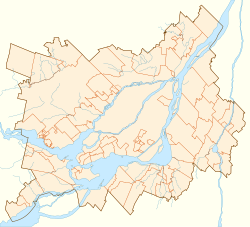Kanehsatà:ke | |
|---|---|
 Location within Deux-Montagnes RCM. | |
| Coordinates: 45°29′N 74°07′W / 45.483°N 74.117°W[1] | |
| Country | |
| Province | |
| Region | Laurentides |
| RCM | Deux-Montagnes |
| Government | |
| • Grand Chief | Victor Akwirente Bonspille |
| • Federal riding | Argenteuil—Papineau—Mirabel |
| • Prov. riding | Mirabel |
| Area | |
| • Land | 11.88 km2 (4.59 sq mi) |
| Population (2022)[3] | |
• Total | 1,364 |
| Demonym | Kanesatakehro:non |
| Time zone | UTC−5 (EST) |
| • Summer (DST) | UTC−4 (EDT) |
Kanesatake (Kanehsatà:ke in Mohawk) is a Mohawk (Kanien'kéha:ka in Mohawk) settlement on the shore of the Lake of Two Mountains in southwestern Quebec, Canada, at the confluence of the Ottawa and Saint Lawrence rivers and about 48 kilometres (30 mi) west of Montreal. People who reside in Kanehsatà:ke are referred to as Mohawks of Kanesatake (Kanehsata'kehró:non in Mohawk). As of 2022, the total registered population was 2,751, with a total of about 1,364 persons living on the territory. Both they and the Mohawk of Kahnawake, Quebec (Kahnawà:ke in Mohawk), a reserve located south of the river from Montreal, also control and have hunting and fishing rights to Doncaster 17 Indian Reserve (Tiowéro:ton in Mohawk).[4]
The Mohawk people historically are the most easterly nation of the Haudenosaunee (Six Nations Iroquois). By 1730, this confederacy was made up of six Iroquoian-speaking nations who were based mostly east and south of the Great Lakes, in present-day New York along the Mohawk River west of the Hudson, and in Pennsylvania. They also controlled hunting territory by right of conquest that extended into the Ohio and Shenandoah valleys.
After French exploration and its beginnings of colonial developments, its traders worked with the Mohawk in villages in the Mohawk Valley. Jesuit missionaries evangelized their people. Some Mohawk moved closer for trade with French colonists in what became Quebec, Canada, or settled in nearby mission villages. In the mid-nineteenth century, after Great Britain had taken over former French territory east of the Mississippi River following its defeat of France in the Seven Years' War, its colonial government formally recognized the people of Kanehsatà:ke as one of the Seven Nations of Canada. These were First Nations who were allies of the British.
Today this territory, classified by the federal government as an interim land base, is one of several major settlements in Canada where the Mohawk are self-governing; the others are classified under the Indian Act as reserves. The reserves include Kahnawake and Akwesasne along the St. Lawrence River, both formed during the French colonial period; the Six Nations of the Grand River First Nation, a reserve organized after the American Revolutionary War by the Crown to provide the Iroquois with land in compensation for what they lost of their former territories in the Thirteen Colonies; and Tyendinaga, where the Mohawk constitute the majority of residents.
- ^ Cite error: The named reference
toponymiewas invoked but never defined (see the help page). - ^ Cite error: The named reference
cp2011was invoked but never defined (see the help page). - ^ "Indigenous communities in Quebec". 15 October 2021.
- ^ "Mohawks of Kanesatake" Archived 2009-07-26 at the Wayback Machine, Aboriginal Communities, Government of Canada


